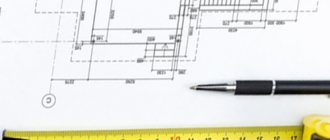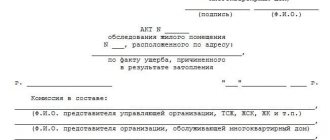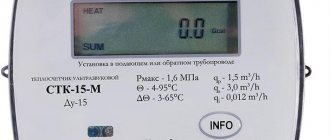Obligation to pay for the maintenance and repair of visual equipment in the apartment building
Management organizations issue invoices to the owners of non-residential premises for the maintenance and repair of the common property of apartment buildings. The owners of such premises refuse to pay the received payment documents, arguing that they do not have a contractual relationship with the management company.
By virtue of clause 2 of Art. 8.1 of the Civil Code of the Russian Federation, the right of ownership of property subject to state registration arises, changes and terminates from the moment the corresponding entry is made in the state register, unless otherwise provided by law.
The owner bears the burden of maintaining the property he owns (Article 210 of the Civil Code of the Russian Federation).
Common property in an apartment building belongs to the owners of the premises on the right of common shared ownership, in accordance with clause 1, part 1, art. 36 Housing Code of the Russian Federation. The common property of apartment buildings includes premises that are not parts of apartments and are intended to serve more than one room in such a building:
- inter-apartment landings;
- stairs;
- elevators;
- elevator and other shafts;
- corridors;
- technical floors;
- attics;
- basements with utility lines;
- other equipment serving more than one room.
Each participant in common shared ownership is obliged, in proportion to his share, to participate in the payment of taxes, fees and other payments on common property, as well as in the costs of its maintenance and preservation (Article 249 of the Civil Code of the Russian Federation).
Owners of premises in apartment buildings bear the burden of expenses for maintaining common property in an apartment building (Part 1 of Article 39 of the Housing Code of the Russian Federation).
In accordance with Part 2 of Art. 154 of the Housing Code of the Russian Federation, payment for residential premises and utilities of the owner of the premises in an apartment building includes payment for services and work on managing such a house, for the maintenance and ongoing repairs of common property in an apartment building, for utility resources consumed during the use and maintenance of public buildings in an apartment building.
The owner's obligation to pay maintenance and repair costs is not conditioned by the existence of a contractual relationship with the management organization. This conclusion can be found in paragraph 24 of the Review of judicial practice of application of the legislation of the Russian Federation on the contract system in the field of procurement of goods, works, services to meet state and municipal needs, approved by the Presidium of the Supreme Court of the Russian Federation on June 28, 2017.
By virtue of Part 2.3 of Art. 161 of the Housing Code of the Russian Federation and clause 10 of the Decree of the Government of the Russian Federation of August 13, 2006 No. 491, the performance of work and provision of services for the maintenance of the common property of an apartment building is mandatory for the management organization in accordance with the legislation of the Russian Federation. The MA cannot refuse to perform such work and provide services even if a state or municipal contract has not been concluded.
The fact that the owner of non-residential premises did not take action to conclude a contract to fulfill the obligation to bear expenses for common property does not relieve him of the obligation to pay the appropriate fee.
Thus, the owner of a non-residential premises located in an apartment building, by virtue of the direct instructions of the law, is obliged to bear the costs of maintaining the common property, unless otherwise provided by law or contract.
Debt collection in the housing and communal services sector (part I)
133150
NTVP "Kedr - Consultant"
LLC "NTVP "Kedr - Consultant" » Services » Legal consultations » General civil issues » Conflict of interests of the organization located in the annex to a residential building and the management company servicing the residential building (expenses for one-way service)
Question.
The building in which the organization is located was built as an extension to a residential building, with which it has common communications. The organization's ownership is registered as a separate building, there is no technical passport, and there is no construction project. An agreement was signed with the management company, in which all expenses for one-way taxation were removed by a protocol of disagreements. Currently, the Criminal Code is once again trying to bill us for general house needs, citing judicial practice and the fact that according to the project (which we do not have) this building was an extension to a residential building
Lawyer's answer.
In accordance with Art. 210 of the Civil Code of the Russian Federation, the owner bears the burden of maintaining the property belonging to him, unless otherwise provided by law or contract.
Art. 210, “Civil Code of the Russian Federation (Part One)” dated November 30, 1994 N 51-FZ (as amended on March 28, 2017) {ConsultantPlus}
By virtue of Art. 36 of the Housing Code of the Russian Federation, the owners of premises in an apartment building own, by right of common shared ownership, the common property in the apartment building, namely:
- premises in this house that are not parts of apartments and are intended to serve more than one room in this house, including inter-apartment landings, stairs, elevators, elevator and other shafts, corridors, technical floors, attics, basements in which there are engineering communications, other equipment serving more than one room in a given house (technical basements);
- other premises in this house that do not belong to individual owners and are intended to meet the social and everyday needs of the owners of premises in this house, including premises intended for organizing their leisure time, cultural development, children's creativity, physical education and sports and similar events;
- roofs enclosing the load-bearing and non-load-bearing structures of a given house, mechanical, electrical, sanitary and other equipment located in a given house outside or inside the premises and serving more than one room;
- the land plot on which this house is located, with elements of landscaping and improvement, other objects intended for the maintenance, operation and improvement of this house and located on the specified land plot.
According to Art. 39 of the Housing Code of the Russian Federation, owners of premises in an apartment building bear the burden of expenses for maintaining common property in an apartment building. The share of mandatory expenses for the maintenance of common property in an apartment building, the burden of which is borne by the owner of the premises in such a house, is determined by the share in the right of common ownership of the common property in such a house of the specified owner.
The share in the right of common ownership of common property in an apartment building of the owner of the premises in this building is proportional to the size of the total area of the specified premises (Article 37 of the Housing Code of the Russian Federation).
The Resolution of the Presidium of the Supreme Arbitration Court of the Russian Federation dated November 9, 2010 N 4910/10 in case N A71-9485/2009-GZ states that the owner of non-residential premises located in an apartment building, by virtue of the direct instructions of the law, is obliged to bear the costs of maintaining common property, regardless of the availability he has expenses for maintaining his own premises, which are individually owned, and expenses for utilities. The maintenance of one’s own premises, payment for utilities consumed therein, as well as the maintenance of a land plot provided for individual use and not included in the common property of an apartment building, do not relieve the owner of the premises from the burden of expenses for maintaining the common property of an apartment building, including a land plot for where the house is located.
In the conceptual apparatus specified in clause 2 of the Rules for the Provision of Utilities - the owner of premises in an apartment building, residential building, household, as well as a person using, on another legal basis, premises in an apartment building, residential building, household, consuming utilities.
Non-residential premises in an apartment building are premises in an apartment building specified in the design or technical documentation for an apartment building or in the electronic passport of an apartment building, which is not a residential premises and is not included in the common property of the owners of premises in an apartment building, regardless of the presence of a separate entrance or connection (technological connection) to external networks of engineering and technical support, including built-in and attached premises. These Rules equate to non-residential premises parts of apartment buildings intended to accommodate vehicles (car spaces, underground garages and parking lots provided for in the design documentation);
The owners of the premises are understood as the owners of both residential and non-residential premises who own the common property of an apartment building by the right of common shared ownership and are obliged to bear the burden of its maintenance in the form of payment for one-room rent.
Built-in non-residential premises
In practice, two types of non-residential premises can be distinguished: built-in and attached, each having its own special status.
A distinctive feature of the built-in non-residential premises is its inextricable connection with the apartment building, which is a single piece of real estate, which is confirmed by registration documents (certificate of ownership), technical passport and other documentation for the apartment building.
The obligation to pay for electricity to the ODN of the owner of a built-in non-residential premises arises from the moment ownership of it arises, regardless of whether the latter has its own separate entrance to the non-residential premises and the actual non-consumption of electricity supply services to common areas, the presence of a separate technical connection, bypassing the intra-house electrical networks.
This position is confirmed by judicial practice.
FAS SZO in its Resolution dated May 14, 2010 in case No. A56-56016/2009 concluded that the presence of a separate entrance to the premises is not a basis for relieving the owner of non-residential premises from bearing the burden of expenses for maintaining the common property of the owners of residential premises in an apartment building.
The Nineteenth Arbitration Court of Appeal in its Resolution dated July 16, 2013 in case No. A48-4560/2012 indicated that the owner of a non-residential premises, regardless of whether he has a separate entrance, and also regardless of whether he uses the entrance, roof, elevator or other common property apartment building, is obliged to pay for utilities purchased for the general needs of the apartment building. A significant circumstance of legal significance for incurring expenses for the maintenance of common property and for paying for utilities consumed in common areas is the fact that the non-residential premises are located in an apartment building.
The Sixth Arbitration Court of Appeal in Resolution No. 06AP-2128/2012 dated June 1, 2012 in case No. A37-1985/2011 established that the obligation to bear the burden of expenses for the maintenance of common property does not depend on whether the owner uses individual objects of common property. Independent maintenance by the defendant of electrical equipment and networks under his jurisdiction does not relieve the owner from the responsibilities for maintaining the common property assigned to him by law.
Attached non-residential premises
Attached non-residential premises are non-residential premises that are an independent piece of real estate, attached to a multi-apartment residential building, have independent engineering communications and are located on a designated plot of land.
The owner of an attached non-residential premises who meets all the stated requirements does not have to pay for one.
FAS DO in Resolution dated 03/04/2014 N F03-125/2014 in case N A73-4173/2013 made the following conclusion: due to the fact that the premises are located in a two-story building attached to an apartment building on a separate plot of land, the engineering systems of which have their own connection points to main utility networks and are an independent piece of real estate, in this case the courts had no reason to consider the defendant a person obligated to bear the costs associated with the provision of utilities for general house needs.
Documents - grounds confirming these facts are:
- documents on ownership of the property (the attached non-residential premises must be assigned a new address);
— documents for the land plot on which the non-residential premises are located;
— documents confirming the presence of independent engineering communications, different from the intra-building networks of an apartment building;
— technical passport for an apartment building;
— technical passport for non-residential premises.
It is important to note that if the technical passport for an apartment building initially provides for the presence of an attached non-residential premises, then it will be considered part of the multi-apartment residential building, and the owner of such premises must bear responsibilities for paying the DST on an equal basis with the owners of built-in non-residential premises.
The absence of independent engineering communications is also the basis for charging fees for one-way service.
The Fifteenth Arbitration Court of Appeal in Resolution No. 15AP-22479/2013 dated February 28, 2014 in case No. A53-12874/2013 comes to the conclusion that it is justified for the owner of non-residential premises to bear expenses for general house needs on the basis that the extension and the house were built at the same time , the house has a single input, separate inputs and technological connections to networks for receiving water supply, there is no heating in the extension.
If an individual metering device is connected after a collective (common house) metering device and the latter, in turn, takes into account the readings, including the individual metering device of the owner of a non-residential premises, a fee for ODN is charged in this case.
The Sixth Arbitration Court of Appeal in Resolution No. 06AP-4339/2012 of October 10, 2012 in case No. A16-261/2012 indicated that the collective metering device of an apartment building takes into account the entire volume of energy supplied to supply both the premises located in the house itself and and an extension adjacent to the house and owned by the entrepreneur. That is, the electricity supply to the residential building and the non-residential premises of the defendant is carried out through a single engineering network and in the existing scheme it is impossible to single out the supply of the entrepreneur’s premises as a separate component, which means that for the purposes of calculating charges for electricity consumption, the entrepreneur should be considered as the owner of the non-residential premises of an apartment building, regardless from the address assigned to the object in which the corresponding non-residential premises are located.
Article: ONE for an entrepreneur: to pay or not to pay? (Sitnikova I.) (“EZh-Lawyer”, 2014, N 21) {ConsultantPlus}
Built-in and attached non-residential premises
The main problems in paying maintenance costs and ODN arise for those legal entities and individual entrepreneurs who own built-in and attached non-residential premises. Here the practice differs. Basically, the courts adhere to the position set forth in the Resolution of the Presidium of the Supreme Arbitration Court of the Russian Federation of November 9, 2010 N 4910/10 in case N A71-9485/2009-GZ, according to which the owner of non-residential premises located in an apartment building is, by virtue of the law, obliged to bear expenses for the maintenance of common property and expenses for utilities, regardless of whether he has expenses for the maintenance of premises that are individually owned. Maintaining your own premises and paying for utilities consumed therein do not relieve the owner of the premises from the burden of expenses for maintaining the common property of the apartment building.
To impose the obligation to pay the costs of maintaining common property and to pay for utilities consumed in common areas, a circumstance of legal significance is the very fact of the location of non-residential premises in an apartment building. Thus, the Resolution of the Nineteenth Arbitration Court of Appeal dated July 16, 2013 in case No. A48-4560/2012 states that the owner of non-residential premises, regardless of whether he uses the entrance, roof, elevator or other common property of the apartment building, is obliged to pay for utilities , consumed for general house needs of the apartment building. It is not a basis for exemption from bearing the burden of expenses for maintaining the common property of the owners of premises in an apartment building and the presence of a separate entrance to the premises. Thus, in the Resolution of the Federal Antimonopoly Service of the North-Western District dated May 14, 2010 in case No. A56-56016/2009, it was noted that the court rightly rejected the defendant’s argument that he is not obliged to pay the cost of electricity supplied to public places, since he he has a separate entrance to the premises and does not use these services.
According to the Sixth Arbitration Court of Appeal, set out in the Resolution of June 1, 2012 in case No. A37-1985/2011, the implementation by the owner of independent actions for heat, water and electricity supply, regardless of the residents of the house through separate utility networks, i.e. The implementation by the entrepreneur himself of independent actions to manage his property, which is part of the apartment building, also does not relieve him of his responsibilities for maintaining the common property. A similar approach is contained in the Resolution of the Federal Antimonopoly Service of the Far Eastern District dated February 13, 2012 in case No. F03-6508/2011, which indicated the obligation to pay for general house needs even if the store has a separate entrance and exit, independent from the entrances of the house, and ensuring independent from the residents of the house via separate engineering networks of heat, water and electricity, with reference to the fact that the store premises are located in an apartment building, which consists of three buildings and, according to an extract from the register of capital construction projects, is a single residential building.
Currently, the calculation of payment for residential premises for the owner of a premises in an apartment building is an arithmetic operation of multiplying the amount of the tariff by the area of the premises and the corresponding number of months, as noted in the Resolution of the Presidium of the Supreme Arbitration Court of the Russian Federation dated November 9, 2010 N 4910/10. Therefore, the management company does not have to prove the actual expenses that it incurred in carrying out its actions to manage the house (Resolution of the Federal Antimonopoly Service of the Volga-Vyatka District of January 20, 2014 in case No. A82-340/2013).
The payment for the single-apartment building is collected regardless of whether the management agreement for the apartment building was concluded with the management company or not, if it is proven that services for managing the apartment building were provided. Thus, by the decision of the Arbitration Court of the Nizhny Novgorod Region dated October 8, 2014, supported by higher courts, the claims of Management LLC against Gloria-93 LLC for the collection of arrears of payment for services for the maintenance and repair of the common property of the apartment building were satisfied. Judicial acts are motivated by proof of the fact that the management company provides services and the lack of payment for these services by the company. In a cassation appeal to the Supreme Court of the Russian Federation, the company asked to cancel the above judicial acts and adopt a new judicial act. However, the court did not see any grounds for transferring the cassation appeal for consideration to the Judicial Collegium for Economic Disputes of the Supreme Court of the Russian Federation, since the courts found that the management company provides services for the maintenance and repair of the common property of the apartment building, in which the defendant owns an attached non-residential premises. The conclusion of the forensic technical examination stated that, despite the fact that the residential multi-apartment building and the non-residential attached building owned by the defendant are different real estate objects, from a technical point of view, heating networks are the common property of the objects under study; sewerage also applies to the common property of a residential building and annexed premises.
Let us give an example of a legal dispute with other factual circumstances, but with a similar and, in our opinion, unfounded court decision. When considering the dispute regarding the claim of GUK House of Shoes LLC for the collection of debt on expenses for the maintenance of common property and under the ODN, the defendant indicated that Dom Shoves LLC has a separate entrance, its engineering systems have their own connection points to the main utility networks, different from intra-house networks of apartment buildings. It has its own entrances (exits), its own boiler room, its own electrical panel and its own meters. Household metering devices do not take into account the readings of LLC meters. The main part of the LLC's premises is not located under the roof of an apartment building. In addition, for the entire period of its existence (more than 20 years), it independently concludes all contracts related to the maintenance of its built-in and attached non-residential premises, including contracts for the provision of services for the collection and removal of solid household waste, contracts for the purchase and sale of electricity, gas supplies , for the supply of drinking water and the reception of wastewater. Taking into account such circumstances, the defendant believed that payment to him under the section “Works and services for management in the apartment building” should not be made, since no such work and services are provided for the LLC, and they should not be paid for the costs of the single-room apartment building. However, the Arbitration Court of the Republic of Mordovia, in its Resolution dated October 19, 2015 in case No. A39-4092/2015, satisfied the claims of GUK Shoe House LLC, and the apartment building is connected only by a small part of the roof of the apartment building. In view of this, obliging an entrepreneur to pay for the maintenance of all the property of an apartment building, without taking into account the real autonomy of the non-residential premises, and the absence of the fact of provision of services by the management company, is contrary to the basic principles laid down in civil legislation, including the rule on the proportionality of the amount of mandatory payments and (or) contributions, related to the payment of expenses for the maintenance and repair of common property, the volume and quality of services and work.
When collecting fees for the maintenance of apartment building property in full, the courts often do not take into account that the owners of non-residential premises often independently perform the functions that a management company should perform. At the same time, we note that against the backdrop of a significant number of court cases in which judges chose to turn a blind eye to the real state of affairs and use ready-made tariffs (which, of course, is easier than assessing the extent to which the premises are connected with apartment buildings), court decisions appeared allowing to protect the interests of owners of non-residential premises. Thus, when considering the claim of the State Unitary Enterprise “Directorate of the Single Customer of the Sokolniki District” of Moscow for the recovery from the Lena Makashova Fashion House CJSC of debt for payment of expenses for the maintenance of the common property of the apartment building, the courts of the first and appellate instances established that the non-residential premises of the CJSC are built-in attached to a multi-apartment residential building, located on the 1st and 2nd floors, they represent an independent object, which was built according to a separate project from the residential building. The defendant’s premises have separate entrances and exits to the internal premises, do not have any constructive connection with the residential premises of the apartment building, are not interconnected either functionally or technologically, have their own load-bearing walls on which the floor slabs rest, their own roof, separate from home heating systems, water supply, sewerage, energy supply, ventilation, etc. From the moment non-residential premises were accepted for operation to the present, the defendant has entered into independent agreements with resource supply organizations. Considering the independence of communications located on the defendant’s premises from the communications systems of the residential part of the house, which is confirmed by construction and technical expertise, the courts came to the correct conclusion that Lena Makashova Fashion House CJSC, as the owner of the non-residential premises built-in and attached to the house, is autonomous from a residential building, cannot have the right of common shared ownership of staircases and garbage chutes, etc., located in the residential entrances of the apartment building, and there are no grounds for imposing on the defendant the responsibility for maintaining the common property related to the residential part of the apartment building. In fact, a residential building and built-in and attached premises are independent objects. It was established that the plaintiff did not manage (maintain) the built-in and attached premises, and the defendant independently bore the burden of maintaining his own property. Based on the above, the courts rightfully rejected the claim. A similar decision was made by the Arbitration Court of the Moscow District in case No. A40-201331/14.
Let us note that in the above cases considered by the Arbitration Court of the Moscow Region, the owners owned built-in and attached premises, which apparently allows us to say that these premises are partially located under the roof of an apartment building. However, the court considered the degree of isolation of these premises from the apartment complex to be sufficient to recognize them as actually independent real estate objects. Only property that all co-owners have the opportunity to use can be classified as common property. If the owners of non-residential premises are deprived of the opportunity to use elevators, staircases and similar “common property”, since they really do not have access to it, it is unreasonable to collect from them maintenance fees and ODN, since they cannot be considered co-owners, as they do not have the entire triad of rights of the owner, provided for in Art. 209 of the Civil Code of the Russian Federation.
Thus, when considering cases concerning built-in, attached or built-in non-residential premises, it is necessary to take into account the degree of autonomy of the non-residential premises. If, in fact, non-residential premises are an independent property, although legally they are part of an apartment building, the costs of maintaining common property and the cost of utilities provided for general house needs in the apartment building should not be recovered from the owners.
{Article: Issues of distribution of expenses for the maintenance of common property and utilities provided for general house needs in an apartment building (Malaya T.N., Nesterova T.I.) (“Family and Housing Law”, 2021, N 2) {ConsultantPlus} }
Based on the above, in this situation, if the attached non-residential premises is an independent piece of real estate, has independent engineering communications and is located on an allocated plot of land, then the owner of the attached non-residential premises does not have to pay for one.
The explanation was given by Igor Borisovich Makshakov, legal consultant of LLC NTVP Kedr-Consultant, May 2017.
When preparing the answer, SPS ConsultantPlus was used.
This clarification is not official and does not entail legal consequences; it is provided in accordance with the Regulations of the CONSULTATION LINE ().
Debt collection from owners of non-residential premises
Owners of non-residential premises in apartment buildings are required to pay for housing and communal services according to the same rules as owners of residential premises. The management organization may require the owner of non-residential premises to promptly pay fees for the maintenance and repair of the common property of an apartment building.
If the owner of a non-residential premises refuses to pay the management organization for the maintenance and repair of common property, you should first try to resolve the issue amicably and explain to the owner of the non-residential premises why he is obligated to pay for the maintenance and repairs of the residential premises: send debt payments, letters or try to conclude an agreement about debt repayment.
If the owner refuses to pay the bills, the management company should proceed to pre-trial debt collection: before filing an application to the court, the debtor must submit a claim demanding payment of the debt on a voluntary basis. According to Part 5 of Art. 4 of the Arbitration Procedure Code of the Russian Federation, the debtor is obliged to respond to such a claim within 30 calendar days.
If the debtor refuses or does not respond to the claim at all, the management organization may file a claim in court. The Arbitration Court considers such applications. But it happens that disputes reach the Supreme Court of the Russian Federation.
An example of such a dispute is given in the ruling of the Supreme Court of the Russian Federation dated November 28, 2017 in case No. 305-ES17-10430. In it, the court indicated that the management organization can recover the debt for the maintenance and repair of common property from the owner of non-residential premises.
How to register partial repayment of debt for housing and communal services
74511
Non-residential premises in an apartment building - what is it?
Non-residential parts of an apartment building are premises that do not perform the function of providing adequate living conditions for the residents of a given house.
This part of the building usually has owners with all rights confirmed by documents.
Non-residential premises may accommodate:
- the shops;
- medical institutions;
- offices;
- educational establishments;
- institutions providing personal services, etc.
Typically, such a part of the building has its own owner, who bears the costs of maintaining not only the operated area, but also other places in the apartment building.
What does this mean?
Reference. The opportunity to legally correctly distinguish between different categories of premises is provided by two codes (Civil Code and Housing Code), as well as the law on the rules for registering real estate (No. 122). Article 130 of the Civil Code classifies non-residential parts of buildings as real estate.
However, this is only possible if such premises have boundaries, as well as registration with the cadastre authorities in the appropriate capacity.
Article 15 of the Housing Code provides a complete definition of premises with residential status. The signs of non-residential premises of an apartment building are determined by contradiction. If residential space is considered to be an isolated space suitable for long-term residence of people, then non-residential space is considered to be isolated real estate without conditions for comfortable living.
If we summarize all the signs, then the non-residential parts of the apartment building include:
- isolated properties with real estate properties that have a separate entrance;
- limited spaces related to non-residential buildings;
- places where people do not have the right to live.
All the described features can be considered significant, but the main one is the last one.
Kinds
Not so long ago, at the stage of creating a building project, the purpose of creating non-residential premises was necessarily indicated in advance. Now this requirement has lost its force. For this reason, the intended purpose of the premises is determined after the building is put into operation.
However, this does not mean that the purpose of an object in a residential building depends only on the desire of the owner. There are standards that strictly regulate the operating conditions of facilities not used for housing. In addition, the ability to use premises for any type of activity also depends on the level of impact on the environment where people live. In principle, some work cannot be carried out in an apartment building.
The intended purpose is formed based on the characteristics of the premises and the nature of the activity. If these two criteria do not correspond to each other, special government bodies have the right to require the owner of the property to reassign the occupation or re-equip the premises.
How do they differ from common areas in apartment buildings?
The need to distinguish between these concepts is obvious, since in practice people often do not see the difference between them, which does not contribute to the rational and legally adequate use of apartment building areas.
Reference. The non-residential parts of the building are an analogue of apartments that are not adapted to the needs of the people living in the house. Common areas are those structures of the building that are not isolated from the occupants. Their purpose is for people to use them constantly.
Such places may include:
- landings on stairs;
- corridors outside the apartment;
- attics;
- technical floors;
- garages inside the house;
- basements;
- boiler areas;
- fencing;
- roof;
- staircase with railings;
- heating, cooling and lighting facilities outside apartments;
- transformer booths;
- local area;
- pipes and all equipment providing gas, heat, etc.;
- devices for metering energy consumption;
- engineering audit systems;
- communication systems.
This is an approximate list of common areas in an apartment building, formed as a clear example of the difference between one part of the building and another.
Examples
All parts of an apartment building that are recognized as such by the cadastral registration system can be residential.
Attention! Art. 16 LCD provides an unambiguous list of premises that belong to the housing category.
This includes:
- MKD itself;
- all of its apartments or parts thereof;
- separate rooms.
Classification of premises:
- A house that has received residential status is considered to be a structure consisting of rooms and a complex of other premises.
- Apartments are separate parts of the building with direct access from common areas. They are formed from rooms and places that perform auxiliary functions.
- One room is such a part of the apartment building that can be the object of market turnover. Moreover, its auxiliary premises are located outside the boundaries of the facility.
All premises classified as non-residential are classified according to their intended purpose:
- educational (kindergartens, educational centers, etc.);
- trading;
- sports;
- canteens, restaurants, cafes;
- production;
- intended for the provision of services (sewing and shoe workshops);
- warehouse (storage of non-toxic goods);
- municipal and household;
- medical;
- office
The conclusion from the comparison can be made unambiguous - the difference between the premises of these two categories lies not only in the level of provision with living conditions. These categories are different legal entities with their own purpose.







